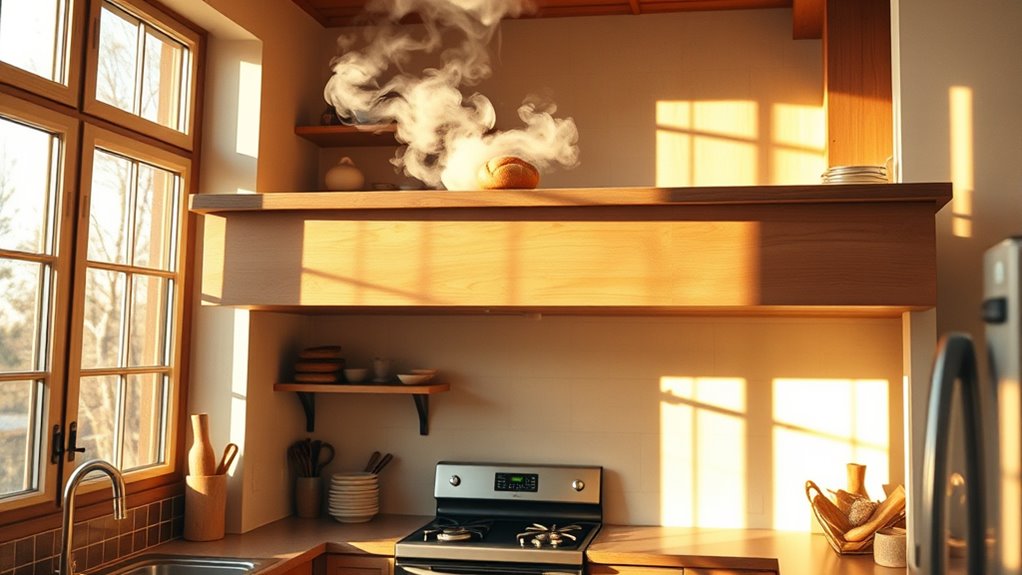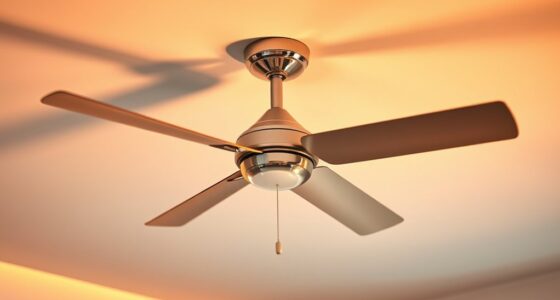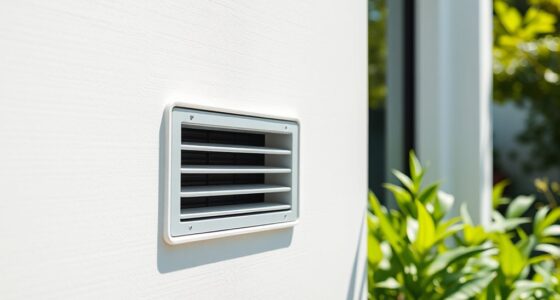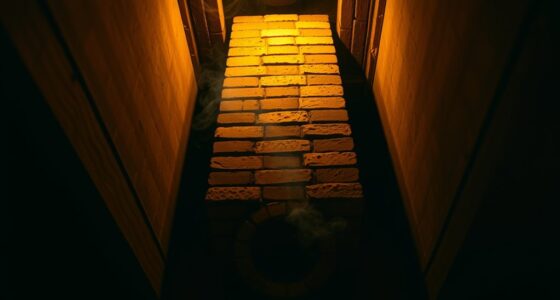The stack effect causes warm air to rise above cooler air, making upstairs rooms feel much hotter. When heated, air becomes less dense and naturally moves upward, trapping heat near the ceiling. This can lead to uneven temperatures and discomfort. To balance this, you can improve insulation, seal leaks, and use fans or ventilation systems to promote even airflow. Want to learn how to control this phenomenon effectively? Keep exploring for practical solutions.
Key Takeaways
- Warm air rises due to reduced density, causing upstairs to become warmer through the stack effect.
- Thermal layering traps heat near the ceiling, leading to uncomfortable temperature differences between floors.
- Poor insulation and leaks intensify heat loss upstairs and exacerbate baking conditions.
- Using ventilation, fans, and insulation can help break thermal stratification and balance indoor temperatures.
- Recognizing warm air movement allows for targeted strategies to improve comfort and energy efficiency.
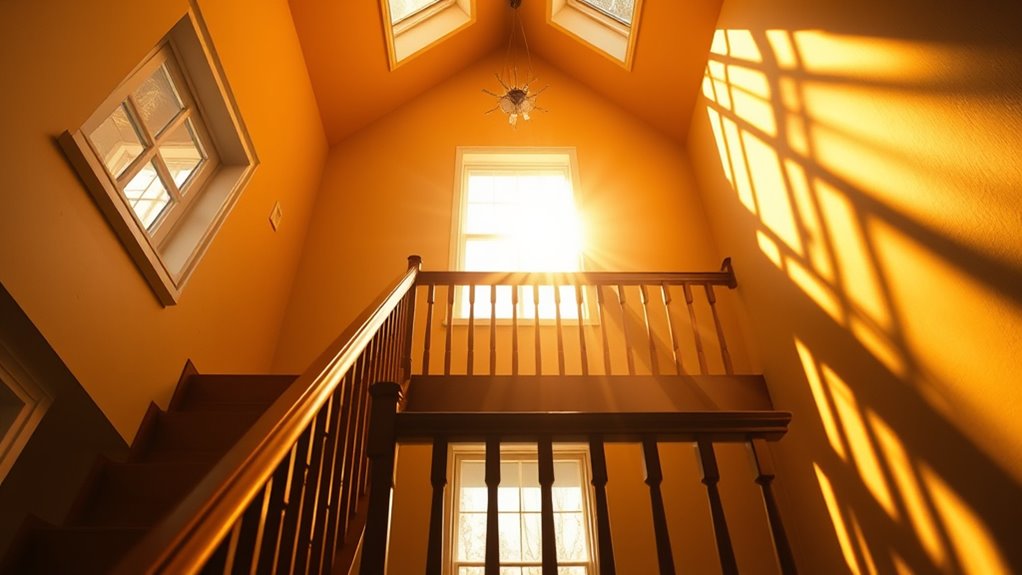
Have you ever wondered why hot air rises inside a building or chimney? It all comes down to the way air behaves when heated, creating a natural air current that influences how heat moves through your home. When warm air is generated—whether from a fireplace, heater, or even sunlight warming the walls—it becomes less dense than the cooler air around it. This difference in density causes the warm air to rise, setting up an upward air current that travels through the interior spaces. As this warm air ascends, it often forms distinct thermal layering, where the temperature varies vertically within a room or building. Near the ceiling, the air can be considerably warmer, trapping heat in that upper zone, while the lower areas stay cooler. This phenomenon is a key part of the stack effect, which explains why upstairs tends to be warmer and sometimes uncomfortably so. Additionally, the integration of automation technologies in managing airflow and temperature can help mitigate these natural effects.
Understanding this process helps you see why heat naturally moves upward and why your upper floors might feel like they’re baking in the summer or retaining heat in the winter. The air current created by thermal layering is driven primarily by temperature differences between the lower and upper parts of a building. As warm air rises, it leaves behind cooler, denser air at the bottom. Without proper ventilation or air circulation, this stratification intensifies, making it harder to maintain a comfortable temperature throughout your home. In winter, the warm air rising and collecting near the ceiling causes heat to escape through leaks or poorly insulated ceilings, while in summer, the hot air can become trapped, making the upper floors uncomfortably hot.
To balance this effect, you need to manage the air current and thermal layering inside your home. Improving insulation, sealing leaks, and installing ventilation systems can help prevent heat from accumulating in the upper areas. Ceiling fans or whole-house fans can promote better air mixing, breaking down the thermal layering and distributing heat more evenly. During colder months, using a heat recovery ventilator can help retain warmth while maintaining air quality. In the summer, shading windows and improving attic insulation can reduce the heat gain that fuels the upward air currents. Recognizing how the natural movement of warm air influences your living space allows you to take targeted steps to create a more balanced and comfortable environment, regardless of the season.
Frequently Asked Questions
How Can I Tell if My Home Is Experiencing the Stack Effect?
You can tell if your home is experiencing the stack effect by observing airflow patterns, like warm air rising and causing drafts or uneven heating. Feel for cold spots near insulation gaps or around windows and doors, especially on the upper floors. If you notice consistent temperature differences and strange airflow, it’s a sign that warm indoor air is escaping through gaps, pulling in cold air from the lower levels.
Are There Specific Seasons When the Stack Effect Is More Noticeable?
Yes, the stack effect is more noticeable during colder seasons when seasonal temperature shifts cause warm air to rise and escape through upper levels. During winter, you’ll feel more upstairs baking or stuffiness due to seasonal airflow patterns pushing warm air upward. Conversely, in summer, the effect diminishes as outdoor temperatures equalize indoor airflow. You might notice uneven heating or cooling more during these specific seasons.
What Health Issues Can the Stack Effect Cause in My Home?
Feeling a bit under the weather at home? The stack effect can subtly impact your air quality, leading to increased mold growth and potential respiratory issues. As warm air rises, it carries pollutants and moisture, creating an environment ripe for mold. To keep your space healthy, guarantee proper ventilation, seal leaks, and maintain consistent indoor temperatures. These steps help balance the stack effect and promote better indoor air health.
Can the Stack Effect Impact My Energy Bills?
Yes, the stack effect can impact your energy bills by increasing air leakage, which forces your HVAC system to work harder. As warm indoor air escapes through gaps and leaks, you lose heat, raising heating costs. This also affects indoor air quality because outside air infiltrates your home. To save money and improve air quality, seal leaks and improve insulation to balance the stack effect effectively.
What Are the Best DIY Solutions to Reduce the Stack Effect?
If you want to tame the massive power of the stack effect, sealing gaps around doors, windows, and vents is your superhero move! Install vents strategically to control airflow, preventing heated air from escaping or rushing in uncontrollably. These DIY solutions can dramatically reduce drafts, balance indoor temperatures, and save you serious energy bills. Take action now—seal, install, and make your home a fortress against the mighty stack effect!
Conclusion
So, next time your upstairs feels like a sizzling oven or a gusty wind tunnel, remember the stack effect is in action. It’s the mighty, invisible force that turns your home into a rollercoaster of temperatures, pulling hot air up and cold air down like a relentless tornado. But don’t worry—you’ve got the power to tame it! With simple balancing tricks, you can turn your house from a fiery furnace into a cozy retreat, no matter what the stack effect tries to throw at you.
